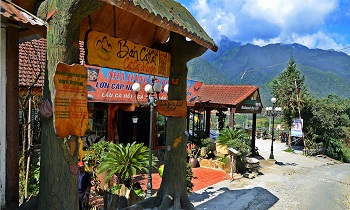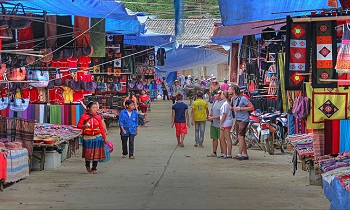
Levels of Trekking in Sapa
Mountainous areas of northern Vietnam is among the best places all over the country for trekking. Depending on their trekking skills, ability, and Sapa trekking tours, tourists can choose the trekking route which is most suitable, as Sapa offers a wide range of trekking spots from easy to hard level.
Sapa easy trekking
An easy trekking route will take you nearly two days, bringing you a brief understanding of Sapa and its tribal residents while watching the stunningly beautiful natural vistas.
From Sapa town, tourists will depart for a walk to Muong Hoa Valley by following the main road for about an hour before turning right to a footpath downhill. People will have a chance to witness the highest part of Hoang Lien Son mountain range, including Fansipan Peak if the weather is beautiful enough. A suspension bridge then will lead you uphill to Y Linh Ho village, where tourists can visit H’ mong people’s house and have a closer view on their daily activities.
After two hours of climbing up and down the hills, people will reach Lao Chai- one large village of H’mong people, and then Ta Van- the area where Zay communities gather. Tourists can choose to stay at Ta Van for a night, to find out more about the culture of ethnics people by joining their meals or visiting local homes and schools.

Trekking in Sapa
The next morning, tourists can take the trail uphill, passing through picturesque terraced rice fields before getting to a bamboo forest and a waterfall. A half-of-an-hour hike will lead to Giang Ta Chai- Red Dao people’s village which is on the top of the hill looking down Muong Hoa River, and if tourists cross another suspension bridge and walk uphill, they will reach Hau Thao Village. People can see many H’ mong and Dao women gathering here for trading and exchanging handicrafts. It is the best way to make friend and feel the hospitality of local ethnic people.
Sapa medium trekking
The route for medium trekking in Sapa is quite similar to the easy one but lasts longer as before heading to Muong Hoa valley, tourists will have a two-hour walk through Cat Cat Village locating near the bottom of the deep valley right at the foot of Fansipan Peak. It is an old village of Black H’ mong people where you can discover many interesting facts about their ordinary life as well as culture and architecture.

Trekking in Fansipan
Sapa hard trekking
Trekking to the top of Fansipan Peak- the Roof of Indochina is the most challenging route for tourists, as they will need to spend three days or join Sapa tour three days four nights completing the hike. Tourists cannot trek by themselves but need a local experienced guide and porter who understand the route deeply.
To reach the first campsite at an elevation of 2300m, tourists will follow the itinerary of passing Cat Cat Village, crossing Muong Hoa River and trekking upward for nearly 7 hours.
The terrain from the first campsite will become steeper and make it difficult to hike as tourists trek through the Arrowroot plantations and bamboo forests. Everybody will spend their night sleeping in a bamboo hut or tent.
The next day will continue with the trek to the second campsite at the altitude of 2900m, passing through primary forest where people can see giant old pine trees and more bamboo. The camping ground is on the mountain slope facing west, near a mountain stream.
The third day will be the summit day as a tourist will climb to the peak of Mt. Fansipan, with the height of 3143m. The final part will take up to three hours due to the dense bamboo forest, but it is worthy as from the peak, tourists can see the best panorama of Vietnam. The last day of the trip is spent on trekking downhill back to Sapa.
We hope that after reading this post, you will understand more about Sapa trekking tours. Visit our website to get further information about this beautiful land. If you find this article useful, please share with others. Thank you!










